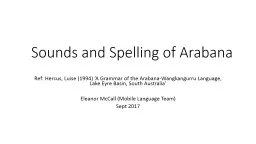

Ref Hercus Luise 1994 A Grammar of the ArabanaWangkangurru Language Lake Eyre Basin South Australia Eleanor McCall Mobile Language Team Sept 2017 The three rs r ID: 651470
Download Presentation The PPT/PDF document "Sounds and Spelling of Arabana" is the property of its rightful owner. Permission is granted to download and print the materials on this web site for personal, non-commercial use only, and to display it on your personal computer provided you do not modify the materials and that you retain all copyright notices contained in the materials. By downloading content from our website, you accept the terms of this agreement.
Slide1
Sounds and Spelling of Arabana
Ref:
Hercus
,
Luise
(1994) ‘A Grammar of the
Arabana-Wangkangurru
Language, Lake Eyre Basin, South Australia’
Eleanor McCall (Mobile Language Team)
Sept 2017Slide2
The three ‘r’s
r
, r, and rrSlide3
r
The
r
represents the retroflex.
Similar to ‘ba
r
n’ said in an American accent
Tip of the tongue curls back in the mouth
r
rr
a
r
ayi
(yes)wara (how/what)
The r represents the tap. Similar to ‘ladder’ said quickly
ngurku (good)tharkarnda (standing
Tip of the tongue taps lightly onto the ridge behind the front teeth
The rr represents the trill.
Similar to ‘ladder’ said quickly and more drawn out like Spanish rolled r
Same tongue placement as r
Roll the tongue more
arru (hello)yakarra (teethSlide4
‘th’, ‘
nh
’, ‘
lh
’
vs. ‘t’, ‘n’, ‘l’What’s the difference between these sounds?Slide5
th
The
th
represents the interdental.
This sound is not used English.
It
does not
sound like ‘thanks’ in English.
Tip of the tongue pokes through the teeth
t
th
anth
i (grandfather, grandchild)antha
(I)The t represents the alveolarThis sounds the same as an English ‘t’, as in ‘time’ and can sound like a ‘d’ at times as in ‘d
og’
anti (soon)nyinta (plants)
Tip of the tongue touches the ridge behind the front teeth Slide6
nh
The
nh
represents the interdental.
This sound does not exist in English.
Tip of the tongue pokes through the teeth
n
nh
a
nh
irnda
(looking)nh
iki (this)
The n represents the alveolarThis sounds the same as an English ‘n’, as in ‘nice’
anpa (you)a
ntha (I) Tip of the tongue touches the ridge behind the front teeth Slide7
lh
The
lh
represents the interdental.
This sound does not exist in English.
Tip of the tongue pokes through the teeth
l
lh
uka
(mother)
wad
lhu (earth)
The l represents the alveolar
This sounds the same as an English ‘l’, as in ‘love’
tyalpa (vegetable food)mil
tyaardi (eye)Tip of the tongue touches the ridge behind the front teeth Slide8
Other sounds in ArabanaSlide9
ly
These
two letters stand for one sound.
Sounds like
mi
ll
ion.
Not like silly.ty
ny
ngadlyuru (green)
These two letters stand for one sound. Sounds like trudg
e. Not like naughty
.
intyara (where)
Tip of the tongue pokes through the front teethThese
two letters stand for one sound. Sounds like canyon. Not like pony.
Middle of the tongue goes to the top of the mouth
*These three sounds all have the same ‘
alveodental’ tongue positionnyilkaru (slowly)Slide10
Tip of the tongue curls back in the mouth
rd
These
are two letters that stand for one sound. As in
quan
d
ong
but with the tip of your tongue curled up and back in your mouth.
rnrl
thangkard
a (sitting)These are two letters that stand for one sound. Sounds like a
nother, but with the tip of your tongue curled up and back in your mouth.
These are two letters that stand for one sound. As in pill
ow, but with the tip of your tongue curled up and back in your mouth.nharla (person)
*These three sounds all have the same ‘retroflex’ tongue position
yukarnda (going)Slide11
ng
Back of the tongue presses against the back of the throat
Sounds like the ‘ng’ in ‘si
ng
’
wa
ng
ka
(language, word)
ngurku (good)Slide12
p - as in s
p
ark. This sound
can sometimes be more like a
‘p’ (
pass) and sometimes more like a ‘b’ (but)
pantyaardi (knee)m- as in m
ad madla (dog, ugly)k- as in skate. This sound can sometimes be more like a ‘k’ (
kite) and sometimes more like a ‘g’ (gate)
kudnaardi (stomach)y- as in
yellow yalka (bush onion)w- as in
wing wangka
(language, word)Slide13
Vowels ‘a, i, u’
Arabana
has three vowels:
‘a’ which sounds like f
ather. It does not sound like b
at m
ara (hand)‘i’ which sounds like beat. It does not sound like hi
t pitha (box-tree)‘u’ which sounds like p
ut. It does not sound like but
kupa (small)Note: Sometimes you will see ‘aa’, this is to represent a ‘k’ deletion (i.e.
pantyaardi=pantya(k)ardi
). It sounds the same as ‘a’ but slightly longer.Slide14
Pre-stopping ‘b’ and ‘d’
‘b’ and ‘d’ are used in
Arabana
specifically to represent a special sound feature called ‘pre-stopping’. Pre-stopping is really
unique
and it is only found a small handful of languages in the world!b
b is occasionally used before m to show pre-stopping. It is not used in any other places, except for the language name itself '
Arabana'wabmara (wind)ku
bmarri (blood)dd
is occasionally used before n, nh, ny, l,
lh, ly to show pre-stopping. It is not used in any other places. pidla
(name)kudnala (sleep)Slide15
Here are all of the sounds in Arabana
r
,r,rr
th
,
nh, lh ty, ny
, lyrd, rn,
rlngp, m, w, y, t, n, l, kb, da, i, u